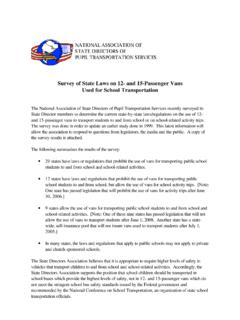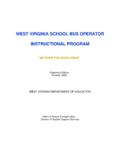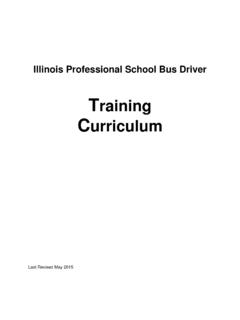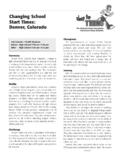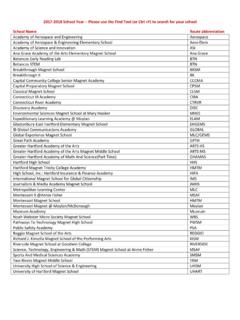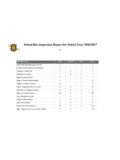Transcription of Identification and Evaluation of School Bus Route …
1 Identification and Evaluation of School Bus Route and Hazard marking Systems Final Report Work Performed Under a Grant From The National Highway Traffic Safety Administration Department of Transportation Grant # DTNH22-97-G-05155 June 1998 National Association of State Directors of Pupil Transportation Services 116 Howe Drive Dover, DE 19901 Identification and Evaluation of School Bus Route and Hazard marking Systems NHTSA Grant # DTNH22-97-G-05155 National Association of State Directors of Pupil Transportation Services Background: An estimated 23 million public School students ride over 400,000 School buses twice daily to go to and from School .
2 Additionally, it has been estimated that another one to two million students ride School buses to and from School -related activities each day. In the course of a School year, School buses transport students over four billion miles. The safety of pupil transportation is of significant concern to Federal, State and local governments, School districts, School administrators, parents, and the general public. Within the School transportation industry itself, there is a long history of significant efforts to make School transportation safe and efficient. Pupil transportation programs date back to the earliest years of the 20th century.
3 By 1910, thirty states had pupil transportation programs in place. The first vehicles used to transport students were nothing more than horse-drawn carts which were borrowed from local farmers. With the development of automobiles and trucks with gasoline-powered engines, the School wagon was replaced with the School truck. During the 1920's and 1930's, the Nation s roadway system was expanding, especially in rural communities. This led to a greater need for vehicles to transport School children and the formation of an industry of School bus manufacturers. As the number of School buses operating on the roadways increased, there came the inevitable problems.
4 Several serious tragedies occurred involving School buses which caused School officials to think seriously about developing safety guidelines for School buses. In 1939, representatives from 48 states gathered to develop recommendations for School buses. Since that time, there have been a total of 12 National Conferences on School Transportation where representatives from each state gather to revise existing and establish new safety guidelines for School buses and operating procedures for the safe transportation of School children, including those with disabilities. The product of these national conferences are referred to as the National Guidelines for School Transportation.
5 The National Conferences are jointly sponsored by the National Association of State Directors of Pupil Transportation Services (which includes the School Bus Manufacturers Technical Council), the National Association for Pupil Transportation, and the National School Transportation Association, the National Safety Council, and Central Missouri State University. To help ensure the transportation safety of students on School buses, the National Highway Traffic Safety Administration (NHTSA) establishes and enforces a series of Federal Motor Vehicle Safety Standards governing the safety performance and manufacture of School buses.
6 NHTSA also conducts a safety defects investigation program to identify safety defects in motor vehicles, including School buses, and requires manufacturers to recall and remedy defective vehicles free of charge. In addition, NHTSA s Guideline #17, Pupil Transportation Safety, establishes minimum recommendations for a pupil transportation safety program, including the Identification , operation, and maintenance of buses used for transporting students; training of passengers, pedestrians, and bicycle riders; and administration. Even with the School bus-specific Federal Motor Vehicle Safety Standards, NHTSA s safety defect investigation and recall program, NHTSA s Guideline #17, and the School transportation industry s National Guidelines for School Transportation, a few School bus safety problems continue to persist.
7 One of these problems was identified as a contributing factor in a tragic crash that occurred on October 25, 1995, in Fox River Grove, Illinois. On that day, a commuter train hit a School bus that was stopped at a highway-railway grade crossing. Seven students were killed and the School bus driver and 24 other students were injured. The School bus driver had taken all of the appropriate actions prior to crossing the railroad tracks, but unknowingly failed to completely clear the railway track while the School bus was stopped at a red traffic light. The commuter train struck the rearmost side of the School bus.
8 At the conclusion of its investigation of the crash, the National Transportation Safety Board identified one of the factors contributing to the crash as an inadequate School district routing and hazard marking system . The Safety Board noted that the substitute School bus driver operating the bus that day was unaware of the hazard at the highway-railroad crossing because the methods employed by the School district to identify and evaluate Route hazards were ineffective. In addition to the Safety Board s investigation of the Fox River Grove crash, the Department of Transportation formed a Grade Crossing Task Force to review the decision-making process for designing, constructing, and operating rail crossings.
9 The Task Force published its findings in a March 1996 report, Accidents That Shouldn t Happen. One recommendation from that report calls for NHTSA to work with State directors of pupil transportation, through relevant national organizations, to develop a system to improve School bus routing safety by focusing on highway-railroad grade crossings. As a result of the recommendations from the Safety Board and the Grade Crossing Task Force, NHTSA provided a grant to the National Association of State Directors of Pupil Transportation Services to: Research the issue of School bus Route hazards and Route hazard marking systems; Develop a set of guidelines that School transportation officials could utilize in developing a system for identifying School bus Route hazards that meets the needs of their locality.
10 Provide suggestions for reasonable and appropriate means of informing School bus drivers of potential School bus Route hazards so as to educate them on how to deal with any Route hazards that can not be avoided; and Suggest methods to disseminate the information developed during this project to the School transportation community. School Bus Driver Training School bus driver training is one of the most important components of the School bus transportation system . A critical component of School bus driver training is the recognition of potential driving hazards and appropriate adjustment of driving behavior to ensure the safety of the School bus occupants.






